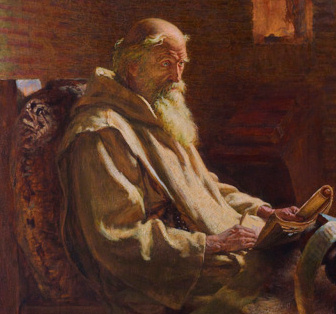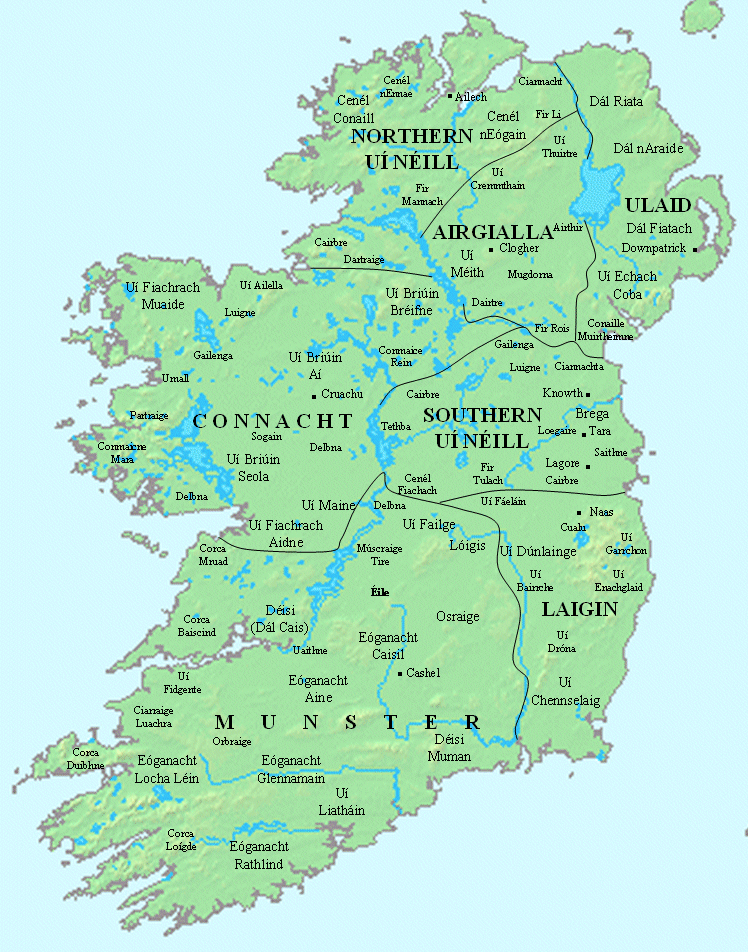|
Ăed RĂłin
Ăed RĂłin mac BĂ©cce Bairrche (died 735) was the DĂĄl Fiatach ruler of the over-kingdom of Ulaid in Ireland. He reigned from 708 to 735. He was the son of BĂ©cc Bairrche mac Blathmaic, (died 718), a previous king of Ulaid who had abdicated in 707 to become a pilgrim. History Opposition to Ăed's rule from the various branches of the DĂĄl nAraidi had to be overcome at first. In 712 the Ulaid (Dal Fiatach) were overthrown and Dubthach mac BĂ©cce, Ăed's brother was slain. In 714 a battle was fought between the sons of Becc Bairrche and the son of Bressal mac Fergusa (died 685) of the UĂ Echach Cobo in which the Dal Fiatach were victors. In 735 the High King of Ireland Ăed AllĂĄn of the CenĂ©l nEĂłgain defeated Ăed RĂłin at Faughart, in Magh Muirtheimhne in modern County Louth. Ăed RĂłin and Conchad mac CĂșanach of Ui Echach Coba were slain. This conflict had arisen as a result of a profanation of a church, Cell Conna, dear to Ăed AllĂĄn by one of Ăed RĂłin's men, for whic ... [...More Info...] [...Related Items...] OR: [Wikipedia] [Google] [Baidu] [Amazon] |
DĂĄl Fiatach
DĂĄl Fiatach was a Gaelic Ireland, Gaelic dynastic-grouping and the name of their territory in the north-east of Ireland, which lasted throughout the Middle Ages until their demise in the 13th century at the hands of Normans in Ireland, Normans. It was part of the over-kingdom of Ulaid, and they were its main ruling dynasty for most of Ulaid's history. Their territory lay in eastern County Down. Their capital was DĂșn Lethglaise (Downpatrick) and from the 9th century their main religious site was Bangor Abbey. Description The DĂĄl Fiatach are claimed as being descended from Fiatach Finn, Fiatach Finn mac DĂĄire, a legendary King of Ulaid and High King of Ireland, and are thought to be related to both the Voluntii and Darini of Ptolemy's ''Geographia (Ptolemy), Geographia''. They are also perhaps more directly related to the pre-historic DĂĄirine, and the later Corcu LoĂgde of Munster. Kinship with the Osraige is also supported, and more distantly with the DĂĄl Riata. The Ulaid ... [...More Info...] [...Related Items...] OR: [Wikipedia] [Google] [Baidu] [Amazon] |
Armagh
Armagh ( ; , , " Macha's height") is a city and the county town of County Armagh, in Northern Ireland, as well as a civil parish. It is the ecclesiastical capital of Ireland â the seat of the Archbishops of Armagh, the Primates of All Ireland for both the Roman Catholic Church and the Church of Ireland. In ancient times, nearby Navan Fort () was a pagan ceremonial site and one of the great royal capitals of Gaelic Ireland. Today, Armagh is home to two cathedrals (both named after Saint Patrick) and the Armagh Observatory, and is known for its Georgian architecture. Statistically classed as a medium-sized town by NISRA, Armagh was given city status in 1994 and Lord Mayoralty status in 2012. It had a population of 16,310 people in the 2021 Census. History Foundation ''Eamhain Mhacha'' (or Navan Fort), at the western edge of Armagh, was an ancient pagan ritual or ceremonial site. According to Irish mythology it was one of the great royal sites of Gaelic ... [...More Info...] [...Related Items...] OR: [Wikipedia] [Google] [Baidu] [Amazon] |
8th-century Irish Monarchs
The 8th century is the period from 701 (represented by the Roman numerals DCCI) through 800 (DCCC) in accordance with the Julian Calendar. In the historiography of Europe the phrase the long 8th century is sometimes used to refer to the period of circa AD 660â820. The coast of North Africa and the Iberian Peninsula quickly came under Islamic Arab domination. The westward expansion of the Umayyad Empire was famously halted at the siege of Constantinople by the Byzantine Empire and the Battle of Tours by the Franks. The tide of Arab conquest came to an end in the middle of the 8th century.Roberts, J., '' History of the World'', Penguin, 1994. In Europe, late in the century, the Vikings, seafaring peoples from Scandinavia, begin raiding the coasts of Europe and the Mediterranean, and go on to found several important kingdoms. In Asia, the Pala Empire is founded in Bengal. The Tang dynasty reaches its pinnacle under Chinese Emperor Xuanzong. The Nara period begins in J ... [...More Info...] [...Related Items...] OR: [Wikipedia] [Google] [Baidu] [Amazon] |
735 Deaths
__NOTOC__ Year 735 ( DCCXXXV) was a common year starting on Saturday of the Julian calendar. The denomination 735 for this year has been used since the early medieval period, when the Anno Domini calendar era became the prevalent method in Europe for naming years. Events By place Europe * Charles Martel, Merovingian mayor of the palace, invades Burgundy. Duke Hunald I of Aquitaine refuses to recognise the authority of the Franks, whereupon Charles marches south of the River Loire, seizing the cities of Bordeaux and Blaye. Within 4 years he will have subdued all the Burgundian chieftains, while continuing to fight off Moorish advances into Gaul. * King Liutprand of the Lombards raises his nephew Hildeprand to co-kingship, after a serious illness (approximate date). * Siege of al-Sakhra: Moors under Uqba ibn al-Hajjaj (governor of Al-Andalus) besiege Pelagius, king of Asturias, in the uppermost Northern mountain ranges in Iberia. The battle ends inconclusively, with Pel ... [...More Info...] [...Related Items...] OR: [Wikipedia] [Google] [Baidu] [Amazon] |
Kings Of Ulster
The King of Ulster (Old Irish: ''RĂ Ulad'', Modern Irish: ''RĂ Uladh'') also known as the King of Ulaid and King of the Ulaid, was any of the kings of the Irish provincial over-kingdom of Ulaid. The title rĂ in ChĂłicid, which means "king of the Fifth", was also sometimes used. Originally referring to the rulers of the Ulaid of legend and the vastly reduced territory of the historical Ulaid, the title ''rĂ Ulad'' ceased to exist after the Norman invasion of Ulaid in 1177 and the subsequent foundation of the Earldom of Ulster. The Mac DĂșinnshlĂ©ibe dynasty of Ulaid (English: Donleavy / Dunleavy) were given the title of ''rex Hibernicorum Ulidiae'', meaning "king of the Irish of Ulaid", until the extinction of their dynasty by the end of the 13th century. After the earldom's collapse in 1333, the title was resurrected and usurped after 1364 by the Ulaid's chief Gaelic rivals the Northern UĂ NĂ©ill, who had overrun the ruins of the earldom and established the renamed tuath ... [...More Info...] [...Related Items...] OR: [Wikipedia] [Google] [Baidu] [Amazon] |
Castledermot
Castledermot () is an inland town in the south-east of Republic of Ireland, Ireland in County Kildare, about from Dublin, and from the town of Carlow. The N9 road (Ireland), N9 road from Dublin to Waterford previously passed through the village but upon completion of a motorway bypass in 2010, it was re-designated the R448 road (Ireland), R448. The town is in a townland and Civil parishes in Ireland, civil parish of the same name. History The earliest known Parliament of Ireland, Irish Parliament met at Castledermot on 18 June 1264 in Ireland, 1264. Also, the oldest intact window in Western Europe can be found in the town, being part of the ruins of a Franciscan Monastery. The window, although large, is only stonework. St. Laurence O'Toole, (1128 in Ireland, 1128 - 1180 in Ireland, 1180) or LorcĂĄn Ua Tuathail, was born at Castledermot. In July 1903 the Gordon Bennett Cup in auto racing, Gordon Bennett Cup passed through Castledermot. Public transport Bus The main bus rou ... [...More Info...] [...Related Items...] OR: [Wikipedia] [Google] [Baidu] [Amazon] |
UĂ Blathmaic
Blathewyc or Blathewic () is the name of several historical territorial divisions in what is now County Down, Northern Ireland. It is the anglicised name of an ancient Irish ''tĂșath'', ruled by the ''UĂ Blathmaic'', later becoming a barony, bailiwick, and county in the Anglo-Norman Earldom of Ulster. UĂ Blathmaic Blathewyc is an anglicisation of the Irish tribal name ''UĂ Blathmaic'', which means the "descendants of Blathmac". They take their name from Blathmac, who was of the DĂĄl Fiatach. Blathmac is cited as being the son of Ăed RĂłin mac BĂ©cce Bairrche, an over-king of Ulaid who died in 735. Their territory roughly matched the later barony of Castlereagh Lower. According to historian James O'Laverty, "Their territory extended from the vicinity of Bangor to that of Carrickmannon, and included the modern civil parishes of Holywood, Dundonald, Comber, Killinchy, Kilmood, Tullynakill, with parts of Bangor, Newtownards, and Knock-breda."O'Laverty, James (1878)"The Ter ... [...More Info...] [...Related Items...] OR: [Wikipedia] [Google] [Baidu] [Amazon] |





